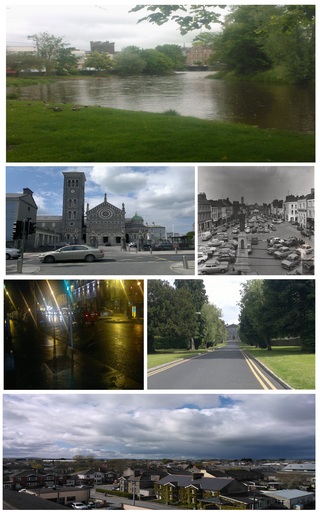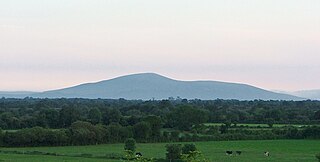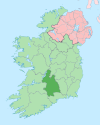
County Tipperary is a county in Ireland. It is in the province of Munster and the Southern Region. The county is named after the town of Tipperary, and was established in the early 13th century, shortly after the Norman invasion of Ireland. It is Ireland's largest inland county and shares a border with eight counties, more than any other. The population of the county was 167,895 at the 2022 census. The largest towns are Clonmel, Nenagh and Thurles.

Thurles is a town in County Tipperary, Ireland. It is located in the civil parish of the same name in the barony of Eliogarty and in the ecclesiastical parish of Thurles. The cathedral church of the Roman Catholic Archdiocese of Cashel and Emly is located in the town.

Ballingarry is a village and civil parish in County Tipperary, Ireland. Ballingarry is one of 19 civil parishes in the barony of Slievardagh, and also an ecclesiastical parish in the Roman Catholic Archdiocese of Cashel and Emly. Ballingarry village is situated near the Kilkenny border on route R691 in the Slieveardagh range. Historically, the area was associated with the coal mining industry.

Fethard is a small town in County Tipperary, Ireland. Dating to the Norman invasion of Ireland, the town's walls were first laid-out in the 13th century, with some sections of these defensive fortifications surviving today.

Urlingford is a town in County Kilkenny, Ireland. It is also a civil parish within the barony of Galmoy. The town is in the north west of the county, along the boundary with County Tipperary, 16 km north-east of Thurles.

Ardfinnan is a small village in County Tipperary in Ireland. It is situated on the River Suir and R665 regional road. The Catholic parish of Ardfinnan is made up of three areas: Ardfinnan, Ballybacon, and Grange. Ardfinnan is also a civil parish in the ancient barony of Iffa and Offa West. The village is located 14 km (9 mi) from the town of Clonmel and 10 km (6 mi) from Cahir via the R670 road. The population of the village is approximately 900 people.

Slievenamon or Slievenaman is a mountain with a height of 721 metres (2,365 ft) in County Tipperary, Ireland. It rises from a plain that includes the towns of Fethard, Clonmel and Carrick-on-Suir. The mountain is steeped in folklore and is associated with Fionn mac Cumhaill. On its summit are the remains of ancient burial cairns, which were seen as portals to the Otherworld. Much of its lower slopes are wooded, and formerly most of the mountain was covered in woodland. A low hill attached to Slievenamon, Carrigmaclear, was the site of a battle during the Irish Rebellion of 1798.
CJ Kickhams Mullinahone GAA club is a Gaelic Athletic Association located in Mullinahone, south County Tipperary, Ireland, close to the border with County Kilkenny. The club is named in honour of Charles J. Kickham, "Poet and Patriot", who was born in the village.

Dundrum is a village in County Tipperary, Ireland. In the 2016 census, the population was 165. It is in the barony of Kilnamanagh Lower.

Holycross is a village and civil parish in County Tipperary, Ireland. It is one of 21 civil parishes in the barony of Eliogarty. The civil parish straddles two counties and the baronies of Eliogarty and of Middle Third. It is also an ecclesiastical parish in the Roman Catholic Archdiocese of Cashel and Emly.
Golden is a village in County Tipperary in Ireland. The village is situated on the River Suir. It is located between the towns of Cashel and Tipperary on the N74 road. In older times the village was known as Goldenbridge. It is also a parish in the Roman Catholic Archdiocese of Cashel and Emly, and is in the historical barony of Clanwilliam.
Killenaule is a small town and civil parish in County Tipperary, Ireland. It is part of the ecclesiastical parish of Killenaule and Moyglass, in the Roman Catholic Archdiocese of Cashel and Emly, and the barony of Slievardagh. It is 19 km (12 mi) east of Cashel on the R689 and R691 roads, at the south-western edge of the Slieveardagh Hills.
Iffa and Offa West is a barony in County Tipperary, Ireland. This geographical unit of land is one of 12 baronies in County Tipperary. Its chief town is Cahir. The barony lies between Clanwilliam to the north-west, Middle Third to the north-east and Iffa and Offa East to the east. The area is currently administered by Tipperary County Council. The barony is within the geographic remit of the Roman Catholic Diocese of Waterford and Lismore.
Iffa and Offa East is a barony in County Tipperary, Ireland. This geographical unit of land is one of 12 baronies in County Tipperary. Its chief town is Clonmel. The barony lies between Iffa and Offa West to the west, Middle Third to the north-west and Slievardagh to the north-east. It is currently administered by Tipperary County Council. The entire barony lies within the geographic remit of the Roman Catholic Diocese of Waterford and Lismore with the exception of the parish of Clerihan which is in the Roman Catholic Archdiocese of Cashel and Emly.
Middle Third is a barony in County Tipperary, Ireland. This geographical unit of land is one of 12 baronies in County Tipperary. Its chief town is Cashel. The barony lies between Eliogarty to the north, Iffa and Offa East to the south, Clanwilliam to the west and Slievardagh to the east. It is currently administered by Tipperary County Council.
Slievardagh is a barony in County Tipperary, Ireland. This geographical unit of land is one of 12 baronies in County Tipperary. Its chief town is Mullinahone. The barony lies between Eliogarty to the north, Iffa and Offa East to the south and Middle Third to the west. It is currently administered by Tipperary County Council.
Grangemockler / Ballyneale GAA is a Gaelic Athletic Association club located in the south-east corner of County Tipperary in Ireland. The club plays Gaelic football and hurling as part of the South division of Tipperary GAA. They have been Tipperary Senior Football Champions on eight occasions.
St Patrick's GAA is a Gaelic Athletic Association club in the parish of Drangan and Cloneen in County Tipperary, Ireland. The club are part of the South Tipperary GAA division.

Kells is a barony in the south-west of County Kilkenny, Ireland. It is one of 12 baronies in County Kilkenny. The size of the barony is 155.6 square kilometres (60.1 sq mi). There are 10 civil parishes in Kells, made up of 167 townlands. The chief town is Kells.

Cloneen is a small village and civil parish in County Tipperary, Ireland. Located on the R692 regional road, the village is approximately 5 kilometres (3 mi) east of Fethard.















